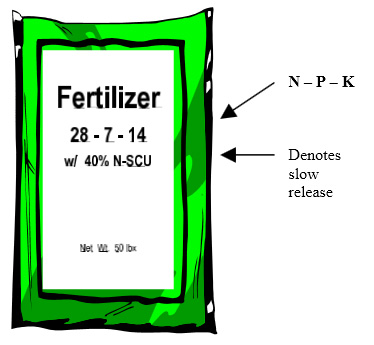Fertilizer Tips
NEW SOD LAWNS
For new sod, it is critical to get the roots established quickly. A fertilizer with an adequate amount of phosphorus is best. By applying a fertilizer with a listing of 16-16-16 (at a rate of: 6.5 lbs / 1000 sq. ft.) to the bare ground, and watering it in lightly before installing the turf, you will greatly help to establish these new roots. Fertilize your new lawn about 4 weeks after installation, with a balanced fertilizer such as 16-16-16. Fertilize the lawn when it is dry, followed by a thorough watering. This will reduce the chance of burning the grass. The first 2–3 applications should be with a balanced fertilizer, after which you can follow the guidelines for established lawns provided below.
NEW SEEDED LAWNS
For newly seeded lawns (either hydroseeded or hand seeded) it is important to supply starter fertilizer at the time of seeding. Country Green’s Hydroseeding includes 16–16–16 starter fertilizer. Apply an application after the new lawn has been mowed once or twice (about 30 days after seeding). After that, follow the guidelines for established lawns
ESTABLISHED LAWNS
For established lawns, aim toward 4–6 fertilizer applications per year (each one supplying about 1 lb. of Nitrogen per 1000 sq. ft.). Suggested applications dates can vary depending on weather (especially early spring and/or late fall) and on your level of expectations. These are general guidelines to follow. Fewer or more applications may be necessary depending upon soil type, weather conditions, etc. Remember to apply fertilizer to a dry lawn, then water in well as soon as possible.
This schedule suggests timing for 6 fertilizer applications per year. The number of applications will vary depending on the needs of your lawn. It is best to never apply more than 1 lb of Nitrogen per 1000 square feet at any single application
| Approximately APRIL 1st | Spring fertilizer (such as 12-2-8 w/ Moss control). |
| Approximately MAY 15th | Jump Start fertilizer (such as 23-0-6). |
| Approximately JULY 1st | Jump Start fertilizer (such as 23-0-6). |
| Approximately SEPTEMBER 1st | Jump Start fertilizer (such as 23-0-6). |
| Approximately OCTOBER 15th | Jump Start fertilizer (such as 23-0-6). |
| Approximately DECEMBER 1st | Fall fertilizer, (such as 21-0-21 w/ slow release). |
If weeds develop, avoid “Weed and Feeds” (fertilizer and herbicide mixtures). When watered in, the herbicides wash into the roots and can burn them. For best results, use a liquid herbicide spray (such as Bayer Advanced Lawn Weed & Crabgrass Killer or equivalent) and let it dry a minimum of one hour before watering the lawn.
Do NOT apply weed killers to newly seeded lawns until reading the restrictions on the label.
TROUBLESHOOTING
- “My lawn is yellow or light green”. It is time to fertilize. An overall yellowing of the lawn indicates nutrient deficiency.
- “I fertilized, but there are stripes in my lawn”. Usually indicated by uneven application of fertilizer. If you are using a drop spreader, apply half the rate, then turn 90º and apply the second half perpendicular to the first application. This will reduce the chance of skips and overlaps resulting in a more even greening up of your lawn.
- “I fertilized my lawn, but am not seeing any response.” This could be due to several factors. Make sure the correct amount was applied and that enough time has passed from the time of application (4 to 7 days). Other factors could be a lack of water, soil compaction, too low of soil pH, lack of soil microbial activity (a problem especially in really wet soils, or during winter months) or high amount of wood product in the soil (this tends to tie up the nutrients, making them unavailable to the turf).
WHAT DO THE NUMBERS ON THE BAG MEAN?
All fertilizers have a chemical listing of N-P-K. As an example a fertilizer listing of 16-16-16 contains 16% Nitrogen, 16% Phosphorous, and 16% Potassium. Some fertilizers contain trace elements, slow release nitrogen, and organic sources of nutrients.

P = Phosphorous is the second number in the analysis. This nutrient is for root development and is especially important for young turf. The rapid growth associated with germination requires phosphorous, therefore it is essential in starter fertilizers. Less is required in established turf. Phosphorous is currently banned in Washington State for existing lawn applications, except if a soil test determines that your soil is deficient in this element. Fertilizers with Phosphorous should only be used be used in new seeding/sodding applications or in lawn repair/renovations.
K = Potassium, also known as Potash) is associated with the plants ability to withstand stress. When supplied to the plant along with adequate amounts of Nitrogen, potassium thickens the cell wall. This makes the plant better able to withstand drought, insects, disease and cold.
HOW MUCH DO I USE?
Follow the label rates on the bag. You can calculate this yourself also. The amount of fertilizer to apply to established lawns is based on the nitrogen level. The recommended amount of Nitrogen to apply for Western Washington is 4–6 pounds of “actual nitrogen” per 1000 sq. ft. per year. Fertilizer should be applied in 4–6 applications per year, each one providing approximately 1 lb. of actual Nitrogen per 1000 sq. ft.. The nutrients on a bag of fertilizer are expressed as a true percentage by weight.
Example: 16-16-16 contains 16% of N, 16% P2O5 and 16% K2O. This means that every 100 lbs. of 16-16-16 contains 16% or 16 lbs of each major nutrient. Therefore a 50 lb. bag contains 8 lbs. of N (“actual nitrogen”) and would provide 1 lb of Nitrogen per 1000 sq. ft. when spread evenly over 8000 square feet of lawn area.











